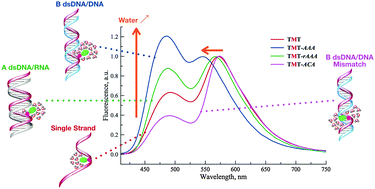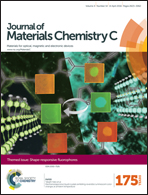Dual emissive analogue of deoxyuridine as a sensitive hydration-reporting probe for discriminating mismatched from matched DNA and DNA/DNA from DNA/RNA duplexes†
Abstract
Fluorescent nucleosides with high sensitivity to H-bonding are of great interest not only to investigate DNA hydration and DNA–protein interactions and dynamics, but also to develop screening assays. Here, we report on the incorporation of a dual emissive uridine analogue based on the 3-hydroxychromone scaffold (3HC) into DNA oligonucleotides of different sequences and the characterization of the spectroscopic properties of the labelled oligonucleotides in matched and mismatched duplexes and in duplexes of different forms. The probe exhibits two-colour emission and spectral λ-shift, which vary as a function of the local hydration of the 3HC. It provides the highest sensitivity together with calibration on the molecular level, which allows discriminating between matched and mismatched dsDNA, as well as between B- and A-forms of DNA/DNA and DNA/RNA duplexes. We suggest that the physical basis of such behavior is the change of hydration in the close proximity of the fluorescent base emitter which appears ideally suitable for such sensing.

- This article is part of the themed collection: Shape-Responsive Fluorophores


 Please wait while we load your content...
Please wait while we load your content...